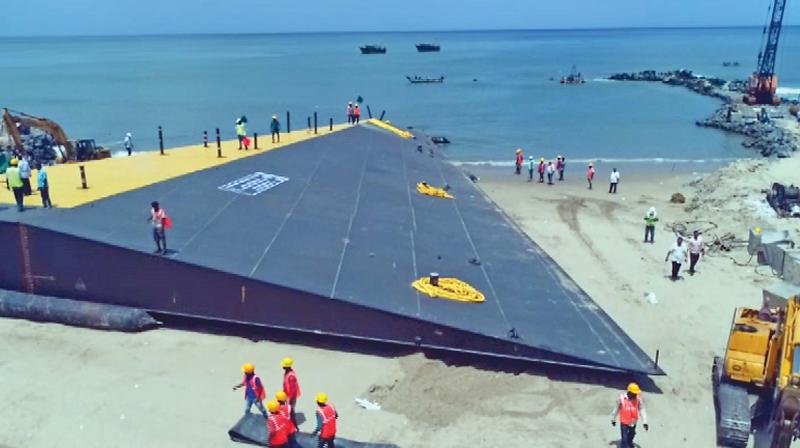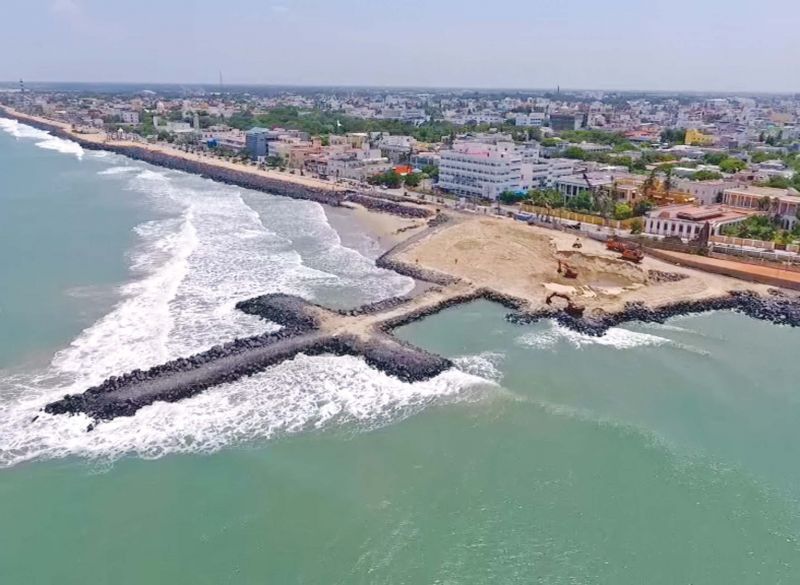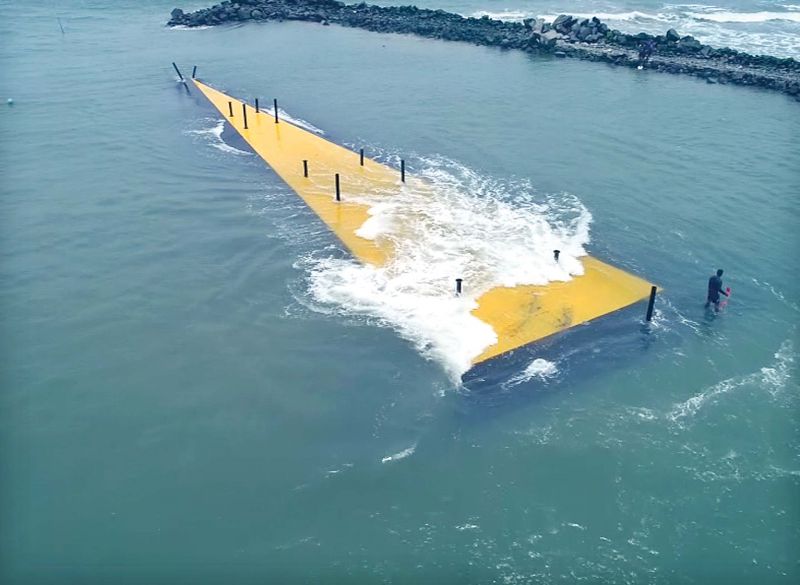Artificial reef helps restore lost Pondy beach

Puducherry: The project to restore the lost beach in Puducherry town limits has yielded fruitful results with the successful immersion of an artificial reef structure, made of steel caisson with rock bottom, on the northern side.
The construction of the 900 tonne reef, measuring 125x100 metres, was immersed 2.5 metres below sea level on the northern side of the coast. The Chennai-based National Institute of Ocean Technology (NIOT), an autonomous body under the ministry of earth sciences, constructed and immersed India’s first wedge-shaped near shore artificial reef, at Puducherry coast.

The pilot project is estimated to cost Rs 65 crore and is jointly funded by the Puducherry government the ministry of earth sciences and NIOT.
How Puducherry lost its sandy beach
Puducherry lost its sandy beaches, including the most visible stretch of bay down the historic Goubert Avenue, with the construction of the port. Almost within a decade of the construction, in 1989, of its ‘under-performing’ port, which is used more as a fishing harbour, erosion of sand started.
With the absence of naturally occurring sand barriers, wave action erodes the coastline drastically. The local authorities then put up rock walls and groynes that hold back the sea in much the same way a port’s breakwater does, pushing the unresolved issue of erosion further up and down the coast. Puducherry government constructed a seawall from the northern side of the harbour to a distance of about 6km after the city began witnessing coastal erosion due to natural disasters and exploitation. The sandy beach to a distance of about 200m was lost.

The government attempted to restore the beach with dredged sand, but dropped the project midway. Later in March 2017 the government started beach nourishment project with Sanctuary Beach, a Singapore-based consultant, which was selected for the nourishment plan for the promenade stretch starting from the northern side of the harbour.
Disappearing beaches
In a 14-minute documentary titled “India’s Disappearing Beaches - A Wake Up Call” by wildlife and conservation filmmaker Shekar Dattatri Puducherry’s fading beaches are representative of the effect of human intervention along India's coastline.
“Within four years of the construction of the harbour in 1986, the coastal town found its beach had vanished. To protect against erosion, an “ugly sea wall” was built to hold the coastline, but they also obstructed the free flow of sand drift,” the documentary says. The documentary was made in public interest for the Pondy Citizens’ Action Network (PondyCAN).

Beach nourishment project
As part of the Shoreline Management Plan for Puducherry, the ministry of earth sciences, NIOT, and the Puducherry government have designed a project estimated at Rs 65 crore. The project has two parts - beach restoration and shoreline stabilisation. As part of beach restoration, the sand which is stuck in and around the harbour will be removed, while a submerged reef will be built as part of the stabilisation process.
The pilot project will feature one artificial four metre-high, 28,540 sq. mt. ‘nearshore wedge reef’ opposite the Chief Secretariat, which will serve as a ‘mild barrier’ to sediment losses and enable sand to move naturally to the north. A similar 4,200 sq. mt. offshore reef placed at the southern end will create the effect of a tombolo (a sand bar) to hold sand on the city’s foreshore, a report of NIOT said.
Dredging is being undertaken by the Dredging Corporation of India and Puducherry Public Works Department is supervising the project. “Around 0.3 million cubic metres of sand will be required for the beach nourishment. The sand which was dredged from the sea mouth will be put alongside the promenade beach,” an NIOT report says.
NIOT is also planning to launch the submerged structure to reduce wave activity into the shore. While answering to the question on the sustainability of the project Mr Schiavina said, “Beaches are our primary concern and they have to be protected. We have been pushing the government for the past 15 years and something has been materialised now. We have no options left other than the beach nourishment project to save the coastline”.
PondyCan has been actively involved in initiating and facilitating the beach restoration project.
What is artificial reef and how it will prevent erosion
An artificial reef is a man-made, underwater structure, typically built for the purpose of promoting marine life in areas of generally featureless bottom. Artificial reefs may also serve to improve hydrodynamics for surfing or to control beach erosion.
“A wedge-shaped reef, which will be made of steel caisson with rock bottom, is a submerged soft structure that allows the sand to bypass, thereby helping beach formation on the either side. On the other hand, hard shoreline protection structures like breakwaters and groynes bring relief at one end while shifting erosion further up the shoreline. Coastal erosion in the fishing village of Chinna Mudaliyar Chavady near here worsened when groynes were constructed in Thandirayankuppam to its south,” said Aurofilio Schiavina, co-founder of PondyCAN, an advocacy group working on coastal erosion.
The submerged structure will reduce wave activity and allow sand to freely move towards the north and prevent erosion along the coastline. Artificial reefs are one among a range of engineering solutions to uplift the deteriorating life below water. Since fish are attracted to any kind of structure; they aggregate at reefs, thereby multiplying rapidly and thus a valuable experiment in terms of conserving marine life. “Artificial reefs are thus going to support the fishermen community equally,” he said.
Beach nourishment, a boost to tourism
Tourists as well as residents are excited that sand will replace the rocks in the promenade and there won't be any rocks to prevent them from entering the sea. “I used to walk along the sandy beach and when I was young and we used to play here in the sand. Everything has changed over years. Now I am happy that we are getting our beaches back,” said 60-year-old Arulselvan, who came to visit the beach along with his family.
Ishan and Arav from Bangalore also shared their excitement over the sandy beach. “We used to visit Puducherry on our weekends and it is one of the best places to hang out with friends. But one thing that we were not happy about the beach is that we cannot enter the sea or play with the water. Now, we are happy to know that things are changing. Puducherry will now beat Goa in the number of international tourists if the government is maintaining things well,” Ishan said. The tourism department also hopes that the beach nourishment programme will attract more tourists to the Union Territory.
“We will get more tourists after the successful implementation of the project and we have no doubt in that. The pilot project will boost the number of domestic as well as international tourists. Along with this we will also take action to develop our airport. These developments will have surely a positive change in the economy and financial status of the state,” said a senior official of tourism department.

